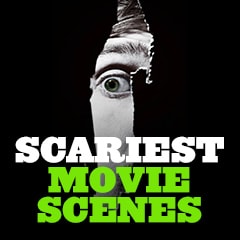
|
| Movie Title/Year and Brief Scene Description | ||||||||||||||||||||||||
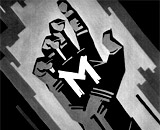
|
M (1931, Ger.) Director Fritz Lang's highly influential film - his first sound film, was an expressionistic psychological thriller about a child molester and murderer who terrorized the German city of Berlin. After school, a little girl named Elsie Beckmann (Inge Landgut) bounced her ball against a billboard, as the shadow of psychopathic Berlin child-killer/molester Hans Beckert (Peter Lorre) moved over the poster of the billboard (reading "10,000 Marks of Reward - Who is the Murderer?") that offered a reward. Beckert leaned down and spoke to the girl, still in silhouette: ("You have a very beautiful ball. What's your name?..."). As he stalked and approached his target by buying her a balloon, he compulsively whistled his motif - Edvard Grieg's "In the Hall of the Mountain King" from the Peer Gynt Suite.
Soon after, Elsie's place setting at the table was unoccupied and both the ball (bouncing away) and the balloon (floating away into telephone lines) were seen - signifying the girl's abduction and murder. An extra edition of the newspaper reported how another young kidnap-murder victim had been claimed (the 9th victim). Beckert was later marked by underworld members with the letter M on his back, until caught and tried in a kangaroo court, and then by a conventional court. |
 Shadow of Child-Killer  Purchase of Balloon from Blind Man for Elsie  Beckert Marked with "M" 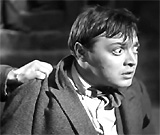 Beckert Apprehended and Tried in Kangaroo Court |
||||||||||||||||||||||
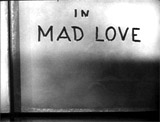
|
Mad Love (1935) Peter Lorre's first American role was in famed cinematographer/director Karl Freund's melodramatic horror film - an adaptation of Maurice Renard's 1920 novel Les Mains d'Orlac. MGM's film was the first direct American remake of the German horror film - director Robert Wiene's The Hands of Orlac (1924, aka Orlacs Hände) starring Conrad Veidt. Lorre portrayed twisted surgeon Dr. Gogol who became obsessed with Parisian Grand Guignol theatre actress Yvonne Orlac (Frances Drake). He was known for his great surgical skills: "He cured deformed children and mutilated soldiers." He had watched Yvonne Orlac's performances from a private box for 47 consecutive evenings at the Theatre des Horreurs, a role that required her to endure bondage and torture for committing adultery. Backstage in her dressing room after the final show, he was shocked to learn that she was married to concert pianist husband Stephen Orlac (Colin Clive), and was leaving for London, England to live with him. To satisfy himself for the time being, Gogol purchased a wax effigy and life-scale figurine of his beloved (displayed in the theatre's lobby) from the waxworks movers who came to remove the theatre's statue of their star performer and melt it down. He referred to the wax statue of Yvonne as Galatea (from the Greek myth). Meanwhile, Stephen was on a train bound for Paris on which police were transporting Knife-Thrower Rollo (Edward Brophy) - a convicted American circus knife-murderer with a deadly talent for throwing knifes. In a stroke of unlucky fate, the train jumped the tracks and Stephen's prized hands were irretrievably crushed. [The execution of Rollo was conducted - by guillotine, as Dr. Gogol, the medical examiner, watched.] Knowing that the amputation of her husband's hands would end his career, Yvonne begged Dr. Gogol to save his precious hands ("Doctor, you don't understand. His hands are his life!"). At the time, Gogol confessed his obsession to her:
She admitted that even if she wasn't married, Gogol frightened and disgusted her. He knew that she would never understand his lustful desires:
She pushed him away: "Liar, hypocrite, you disgust me." Thereafter, Gogol schemed to win her admiration, gratitude and love by acquiring executed Rollo's corpse, chopping off his hands, and transplanting them onto Stephen - without really explaining what he had done. After the surgery and a long period of physical therapy, Stephen's scarred and disfigured hands gradually healed but he couldn't play the piano as before - and he began to realize that he had an uncanny ability to throw knives or other objects with deadly accuracy. Meanwhile Gogol worshipped his wax statue and read from a book:
Accused of killing his stepfather Henry Orlac (Ian Wolfe) and worried about his own guilt with his deadly new hands, Stephen was summoned to visit with a strange man to learn the truth about hishands. The man introduced himself as the decapitated yet revived, brought-back-to-live Rollo. It was a shocking and scary appearance - "Rollo" was dressed in a trenchcoat, with a black Stetson hat, dark sunglasses, metal hands, and a heavy leather and metal neck-brace.
It was implied that "Rollo" was the resurrected-from-the-dead condemned killer Rollo who had been guillotined. He claimed that Dr. Gogol had grafted his hands onto Stephen's wrists, and also reconnected the severed head onto Rollo's body!
To implicate Stephen (and thereby have Yvonne all to himself), "Rollo" led Stephen to believe that he was his step-father's murderer - and that the murder had been committed with the hands that were removed from his body. After Stephen departed and was about to be arrested, in a masterful scene, the maniacal, hysterically-giggling Gogol removed his neck brace (to allegedly keep him from losing his head) and revealed his true identity. Gogol - now increasingly insane - spoke to his wax statue (actually Yvonne who had broken the statue and pretended to take its place) and admitted his guilt and plan to implicate Stephen ("that fool"):
In the somewhat traditional ending, Yvonne was in the murderous clutches of the Gogol madman, after he discovered blood on Yvonne's left cheek and realized his statue of her was alive:
Gogol refused to take Yvonne's rejection and 'no' for an answer, and threatened to strangle Yvonne with her own hair:
She was saved when Stephen opened the panel on the bolted door and expertly threw a knife into Gogol's back. |
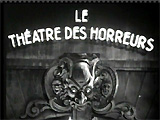 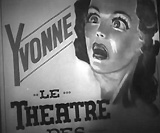 Parisian Theatre des Horreurs 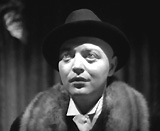 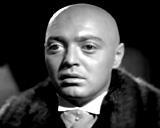 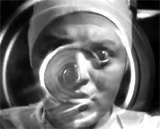 Obsessed Dr. Gogol (Peter Lorre) Over Yvonne Orlac 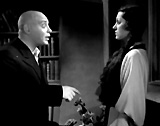 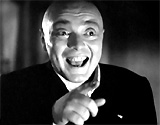 Gogol With Yvonne (Who Was Pretending to be a Wax Statue) 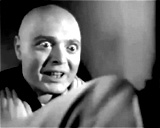 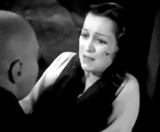 Gogol Finally Realized Yvonne Was Not a Wax Statue - He Attempted to Strangle Her 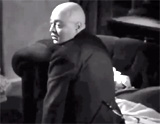 Gogol Knifed in Back By Stephen, Saving Yvonne 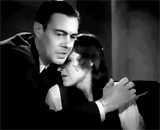 Yvonne and Stephen Reunited for an Embrace |
||||||||||||||||||||||

|
#23 This was the first film to introduce the serial killer character named Hannibal - serving as a prequel to The Silence of the Lambs (1991). It was based on Thomas Harris' 1981 best-selling novel Red Dragon, and from the screenplay by director Michael Mann. The film's original title might have been misinterpreted as a kung-fu movie, so it was renamed with the bland title of Manhunter. This psychological thriller was later re-made as Red Dragon (2002) by director Brett Ratner, starring Anthony Hopkins as Dr. Hannibal Lecktor (now spelled Lecter) and Edward Norton as Will Graham. The film's scariest high-point was the torture and death of obnoxious, sleazy National Tattler tabloid journalist Freddie Lounds (Stephen Lang), who was conducting his own investigation of the Red Dragon murders conducted by a new serial killer named Francis Dollarhyde (Tom Noonan). Dollarhyde had become known as the Tooth Fairy because he left bite-marks on his victims. Lounds was ambushed by The Tooth Fairy serial killer in an underground parking garage. He was chloroformed and kidnapped. During a shocking torture scene, Lounds was blindfolded and strapped in a wheelchair, and taunted: "According to you, I'm a sexual pervert. 'An animal,' you said." Dollarhyde was incensed that Lounds' tabloid had printed a false and derogatory profile of him as the Tooth Fairy. The tall, crazed "Tooth Fairy" enemy with a cleft-palate and scraggly white hair wore a ladies' sheer stocking mask over his head and eyes, and forced Lounds to watch a slideshow beginning with a painting of William Blake's The Great Red Dragon and the Woman Clothed in the Rays of the Sun, with further pictures of his transformed female victims (Mrs. Leeds, Mrs. Jacobi), and imminent future victim Freddie Lounds. The killer told the helpless Lounds:
Lounds was forced to record a note in which he admitted his writings about the Red Dragon killer were lies, and that FBI profiler agent Will Graham (William Petersen) had coerced him to write the untruths (part of the note: "He will be more merciful to me than to you. You will lie awake in fear of what the Red Dragon will do"). The "Tooth Fairy" then announced that Lounds' promise to tell the truth would be sealed:
The screaming Lounds had his lips bitten off (off-screen) and then was set ablaze in the wheelchair. He was rolled down a steep underground parking garage ramp towards the camera - his death occurred later (offscreen) in a hospital. |
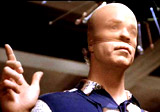 Serial Killer Francis "Tooth Fairy" Dollarhyde (Tom Noonan) 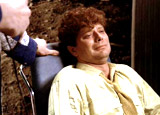 Kidnapped Reporter Freddie Lounds (Stephen Lang) 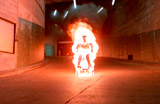 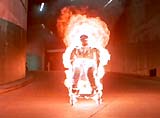 Murder Sequence: The Torture and Death of Freddie Lounds |
||||||||||||||||||||||
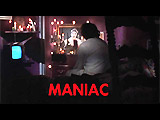
|
Maniac (1980) #5 This was a classic 80s slasher film and controversial, disturbing horror film from director William Lustig, with incredibly gory special effects by bloody make-up guru Tom Savini. The director admitted the film was a compilation of various serial killers in the news at the time, i.e., David Berkowitz and John Wayne Gacy. It was a notorious precursor to Henry: Portrait of a Serial Killer (1986), and was reminiscent of an urban version of The Texas Chainsaw Massacre (1974). The film was remade as Maniac (2012) with Elijah Wood. The gritty splatter movie opened with a nighttime scene of an unidentified male using coin-operated binoculars at a beach to spy on a couple (James Brewster and Linda Lee Walter) on the dunes under a blanket. When the guy went to get wood, the stalker came up to the female and slit her throat. When the boyfriend returned, he was garrotted from behind with a wire. The stalker had been introduced - he was a self-loathing, self-torturing psychopath named Frank Zito (Joe Spinell, the film's co-producer and co-scripter), who often rambled and spoke to himself with an inner monologue, similar to Norman Bates' character in Psycho (1960). The demented and lonely Zito lived in a tiny NY apartment, adorned with a framed picture surrounded by candles of his prostitute mother Carmen. Later, it was revealed that the mama's boy had been abused by her - she locked him in a closet while she entertained tricks. Zito stalked the streets of NYC to find pretty victims to kill and scalp. Then, he would take their clothes and trophy scalps home to dress up his growing mannequin collection. He collected a creepy set of decorated mannequins in his one-room NY apartment. They wore the scalped hair of his female victims (he nailed the bloody tufts of hair onto their heads). He also slept with his 'females' - handcuffed. The deranged, sweaty, pudgy Zito was responsible for many stalkings and deaths strung together in this violent film - committed in a gruesome fashion. Zito's next victim was a hooker (Rita Montone), who was strangled after Frank began to have sex with her in a hotel bedroom. Frank then scalped the woman with a razor.
The most infamous and graphically-violent scene was dubbed the "Disco Boy" sequence. One night, a couple making out in the backseat of a car in a parking lot near one end of the Verrazano Bridge were brutally executed. After spying on the couple, Zito jumped on the car's hood and fired into the windshield at the driver (Tom Savini) - the male's head was exploded with a direct shot from a 12-gauge double-barreled shotgun. Blood splattered over the hysterical female Disco Girl (Hyla Marrow) - and she was also targeted and shot point-blank in the head.
Then, he started dating young British fashion photographer Anna D'Abroni (Caroline Munro) who took his picture in the park. Suspense was created during their seemingly-normal relationship - would he murder her too? There were other misogynistic killing scenes, including:
In the film's ultimate sequence, a baffling and over-the-top scene, Zito woke up in a sweat. He was nightmarishly attacked by his own anthropomorphic bloodied mannequins, who seemed to come alive and surround his bed. They grabbed his implements of death (shotgun, bayonet, knives, etc.), and first dismembered him (cutting off one arm), plunged a bayonet into his abdomen, and then decapitated him by ripping off his head. The next morning, police officers found Frank's corpse on his bed - he had apparently committed suicide after suffering from a nightmare about his mannequins murdering him. After the officers left after a few brief moments (without saying a word or touching anything, strangely), there was a lengthy shot of Frank on his bed -- and then a zoom shot into his eye when it opened! Was he not really dead?
|
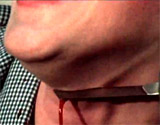 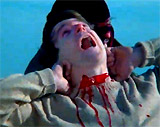 Opening Scene: Throat Slitting and Garroting of Boyfriend at the Beach 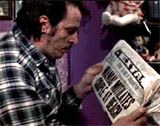 "Maniac" on the Loose 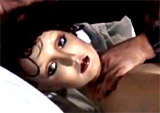  Zito Affixing Trophy Scalps on Mannequins 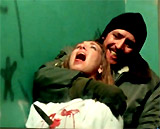 The Subway Murder Scene - Attack on Nurse (Kelly Piper)  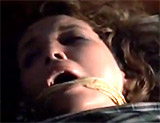 Rita's Bathtub Scene Prior to Her Murder 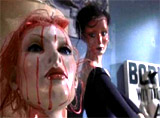 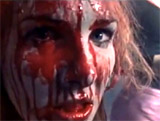 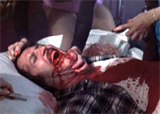 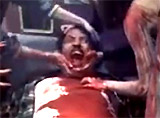 A Nightmare? - Zito Was Decapitated and Dismembered by his Own Anthropomorphic Mannequins |
||||||||||||||||||||||
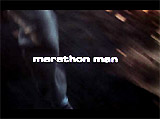
|
#65 Marathon Man (1976) was a scary, paranoid nightmare thriller - best known for its suspenseful pursuit scenes and two truly repellent scenes of dental torture. The main villain was the infamous character of Dr. Christian Szell (Laurence Olivier), who was known for selling stolen contraband diamonds for his own profit (derived from gold taken from Jews' teeth during WWII when he was at Auschwitz, known as "The White Angel, Der Weie Engel, due to his white hair"). In two excruciating and grim scenes (the infamous torture scene was split into two segments), sadistic ex-Nazi death camp dentist Szell proceeded to torture a tied-up victim in a window-less room using probing and buzzing dental instruments on a tray. An early scene set the stage for the two tortures. In a Parisian hotel room, Henry "Doc" Levy (Roy Scheider), a globe-trotting, covert American government agent (in a group known as "the Division") was attacked. He was working to foil aging, fugitive, ex-Nazi war criminals. "Doc" was serving as a diamond courier for Szell in return for Szell's assistance in tracking down other Nazi war criminals. While standing on his balcony with a view of the Eiffel Tower, Doc was garrotted from behind by an assailant, but was able to fight off his brutal attacker and break his neck. "Doc's" brother - an idealistic doctoral history student named Thomas "Babe" Levy (Dustin Hoffman), was taking a bath in his tub in his NYC apartment, when two mysterious intruders entered - he screamed for help, but was seized, dunked head-first into his bathtub, and abducted. The first session of death camp dentist Szell's sadistic, grim torture of "Babe" commenced. In a chair, Babe was constrained while wearing a bathrope and striped PJ bottoms. After methodically washing his hands, Szell repeatedly and calmly asked the baffling question: "Is it safe?" He unrolled a collection of probing, ominous-looking dental instruments, and began to torture him; "Babe" stubbornly refused to divulge any information. After causing intense pain by digging around inside Babe's mouth, Szell applied a dab of a medicinal liquid on his little finger to the affected tooth:
During a second session of torture and interrogation, Szell spoke about how "Doc" (whom Szell had lethally stabbed) had possibly relayed information to "Babe" before his death, and he would now use further torture to extract assurances of safety.
Szell plugged in his loud-sounding, whirring drill (the horror was accentuated by POV shots) and threatened:
"Babe" screamed as the pain increased and then passed out; Szell spoke to his thugs: "He knew nothing. If he'd known, he would have told. Get rid of him." "Babe" was able to escape and engaged in a marathon run across town to get back to his Manhattan apartment. |
 Garrotting of "Doc" Levy (Roy Scheider) in Paris 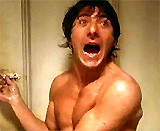 Abduction of "Doc's" Brother "Babe" in NYC |
||||||||||||||||||||||

|
Man Behind the Sun (1988, HK) (aka Hei Tai Yang 731) (aka Men Behind the Sun) This unrated (would have been NC-17 undoubtedly) provocative, unflinching and sickening documentary-style film (denounced by some as an exploitation film even though historically accurate) came from director T.F. Mou. It displayed many of the Japanese atrocities and perverse medical experiments committed toward guinea-pig human victims (Manchurian civilians in NE China) in Unit 731 (a biological warfare R & D experimental unit code-named Maruta) during WWII (and the Second Sino-Japanese War). The experiments were similar to ones committed by the Nazis in Europe. At the height of the conflict, Japan controlled the Korean peninsula, Taiwan, Hong Kong, Shanghai, and Manchuria. They were held in Unit 731 (a biological warfare R & D unit) during WWII (and the Sino-Japanese War). It was claimed that Emperor Hirohito secretly ordered the inhumane lab experiments during Japan's aggressive period of empire-building, including the search for a contagious strain of the bubonic plague to unleash on the Chinese and on other enemies..
It was also criticized for its use of actual autopsy footage for 'live dissections.' The most egregious example depicted a drugged young, mute and naked Chinese boy who was operated upon only with the use of chloroform. His internal organs were extracted from his body while he remained alive. One of the doctors exclaimed how happy he was that they now had healthy organs to experiment with further:
After the experiments, unneeded body parts of the dead were routinely incinerated. Another scene was heavily criticized in which a live white cat was thrown into a chamber and ripped apart by a swarm of hungry rats. In another sequence set in a decompression or hyperbaric chamber, intense pressure caused a man's body to swell, causing his bowels and intestines to shoot out of his anus. In another segment, a woman and her child were gassed to death in a glass-enclosed chamber, while the Japanese commandant and other medical officials observed the ghastly effects. |
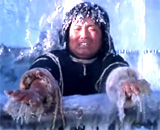 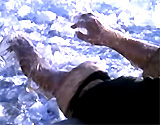 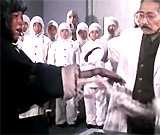 Frost-Bitten Hands Thrust into Hot Water - Exposing Skeletal Bones 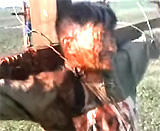 Prisoners Tied to Wooden Crosses and Mutilated by Explosive Bombs 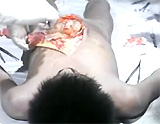 Extraction and Harvesting of Organs on Young Boy While Chloroformed 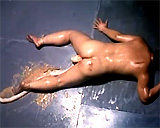
Explosion of Bowels and Intestines Through Anus in Hyperbaric Chamber 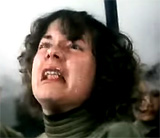 Gas Chamber Murders |
||||||||||||||||||||||

|
Mirrors (2008) French co-writer/director Alexandre Aja's supernatural horror film was an adaptation and remake of Sung-ho Kim's horror film Into The Mirror (2003, S.Kor.). It told about the concept of reflections in mirrors that were haunted or possessed. They could taunt people and cause them to bring harm to themselves. In the graphically-violent celebrated scene, a major set-piece, Angela "Angie" Carson (Amy Smart) - the sister of ex-alcoholic, and ex-NYC police detective Ben (Kiefer Sutherland), entered her bathroom and gazed at her reflection. When she turned away toward the tub, the reflection took on a malevolent and evil life force of its own and caused Angie to suffer harm.
After sinking into a bathtub, the actions of her reflected image in the mirror began to literally tear and pull apart her own jaws. She grabbed the sides of her mouth and slowly pulled them apart - causing massive hemorraghing and flailing about before she perished in her own bloody water. |
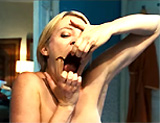  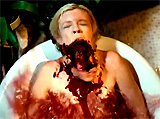
Jaws Pulled Apart |
||||||||||||||||||||||

|
Misery (1990) #12 Kathy Bates won the Best Actress Oscar for her sledge-hammer-swinging/psychopathic fan role in director Rob Reiner's blackish thriller Misery (1990) - another Stephen King adaptation (by William Goldman). Rescuer/nurse Annie Wilkes strangely idolized car accident victim and romance author-writer Paul Sheldon (James Caan) -- ("I'm your number one fan"). Sheldon had penned a series of books about a lovelorn 19th century character named Misery Chastain. Wilkes nursed Sheldon back to health in her place in Colorado. She was sane until she maddeningly learned that the writer had killed off the heroine character. In an earlier tense scene, Paul frantically returned to his bed before Annie returned. Eventually, the obsessed Wilkes made a deranged, frightening decision to 'fix' things so that he would never try to run away. In the very painful 'hobbling' scene, she explained how she could assure that her favorite captive author-writer Paul Sheldon would never leave her:
During a near-rescue scene, the Sheriff (Richard Farnsworth) was killed by a shotgun blast at the last moment. However, in the concluding basement scene, Annie was planning on a double suicide-murder:
But Paul was able to trick Annie into getting a cigarette and second glass for champagne to celebrate completing the manuscript; he found an opportunity to bash her over the head with his typewriter, and although she shot him in the left shoulder, he was eventually able to stuff some of the manuscript into her mouth during a one-on-one fight, and then after tripping her, she fell and suffered a lethal blow to the head when she struck his typewriter. In the haunting ending in a restaurant, a waitress told Paul: "I just wanna tell you I'm your number one fan" - causing Paul continued visions of a now-dead Annie still stalking him. |
 Annie Wilkes: "I'm your number one fan" 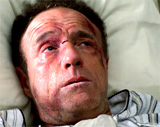 Injured, Bed-ridden Author Paul 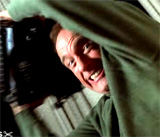 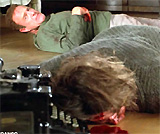 Basement Scene of Revenge: Bashing Annie Over the Head with Typewriter and Killing Her 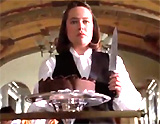 Haunting Concluding Restaurant Scene |
||||||||||||||||||||||
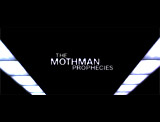
|
The Mothman Prophecies (2002) Director Mark Pellington's X-Files-like horror film starred Richard Gere and Laura Linney. It was an eerie psychological thriller based on a legendary 'true' creature - with black wings, mothlike features and red eyes. The creature was based on true-life events in Point Pleasant, West Virginia that occurred in the mid to late 1960s. John Klein (Richard Gere), a newspaper reporter researching the "Mothman" legend, had a series of chilling, mind-reading phone conversations in his motel room, with the inhuman, supernatural "Indrid Cold" (voice of Mark Pellington, the director) who could read his mind:
The most amazing mind-reading revelations were John's next conversation about a paperback book that he had, and the fate of his wife:
|
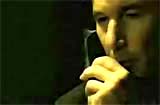 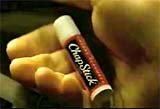
The Eerie Chapstick Scene: A Conversation Between Reporter Klein and 'Indrid Cold' |
||||||||||||||||||||||
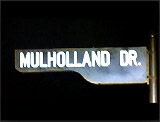
|
Mulholland Dr. (2001) Best Director-nominated David Lynch's surreal, enigmatic, complex, puzzle-box, mind-bending, and unconventional film was about Hollywood, obsession and unrequited love, a contract hit, dashed dreams and suicide. It portrayed the twisting, and shifting identities of its two female protagonists, two femme fatales, each with two personas:
In the modern film noir, both were caught in a nightmarish, Los Angeles web of corruption and death after opening the mysterious Pandora's Box with a blue key. There were two startling, creepy appearances of a deformed, homeless-looking, dirty monstrous dumpster-dwelling crone/vagrant (Bonnie Aarons). Just before his first appearance behind Winkie's diner on Sunset Blvd., Dan (Patrick Fischler) hesitantly, in a long monologue (located at the 12-17 minute mark of the film), told his well-dressed friend Herb (Michael Cooke) inside the restaurant about a dream that they had both been in:
He ended by saying that the dream gave him a "god-awful feeling" that he needed to get rid of. Afterwards with a foreboding feeling of dread, the two left Winkie's and walked around the side of the restaurant, and descended some steps (shot with a POV perspective) - proceeding stealthily and cautiously. From behind a graffiti-decorated concrete dumpster wall, the filthy and repulsive vagrant briefly appeared to them in a quick flash - causing a great jump scare!
It scared Dan into a heart attack, and he fell backwards into Herb's arms. Metaphorically, Dan's story was actually the shocking and terrorizing fear of many individuals, and specifically the plot of the film -- an aspiring Hollywood starlet named Diane (in the persona of Betty), who had come with high hopes to make something of herself in the "city of dreams," failed, was on the verge of homelessness, and had sunk to levels of impoverishment and degradation before literally dying. Later, the black-faced horrible figure also appeared in Diane's vision holding a blue box, right before and after Diane committed suicide.
|
 The Diner Scene Between Dan and Herb 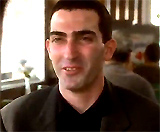 Dan (Patrick Fischler)  Herb (Michael Cooke) 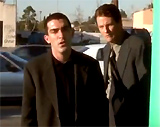 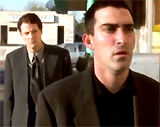 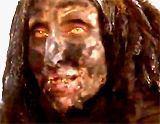 Viewing the Dumpster Vagrant 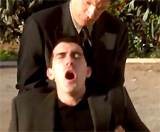 Dan's Heart Attack |
||||||||||||||||||||||
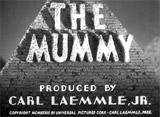
|
The Mummy (1932) In director Karl Freund's classic horror film from the early 1930s, there was:
After being resurrected, 10 years later, the Mummy lived under an alias as gentlemanly but sinister-looking Egyptian Ardath Bey. When he saw Helen Grosvenor (also Zita Johann), he believed that she was his long-lost reincarnated ancient princess love Anck-es-en-Amon from thousands of years before. His objective was to kill her on an altar, then mummify (or embalm her in a bath of natron to make her a "living mummy" like himself), place her in her original sarcophagus, and then resurrect her, and make her his immortal bride. In the climactic conclusion, Ardath attempted to kill Helen (in Egyptian garb) by plunging a sacrificial dagger into her stomach as she laid on the altar. She objected to his crazed plan: "No, I'm alive. I'm young! I won't die! I loved you once but now you belong with the dead. I am Ankh-es-en-amon, but I-I'm somebody else too. I want to live, even in this strange new world!....The bath of natron. You shall not plunge my body into that!" She jumped up and prayed to a large black statue of the goddess Isis to save her and offer forgiveness and protection: ("Oh Isis, holy maiden, I was thy consecrated vestal. I broke my vows. Save me now! Teach me the ancient summons, the holy spells I've forgotten. I call upon thee as of old!"); the statue responded by raising its right arm with an emitted ball of flame from an ankh symbol in its hand to set the Scroll on fire.
The spell was broken that kept the curse functioning, and in a stunning transformation scene, Ardath's face dried, crumbled and deteriorated as Helen was saved. |
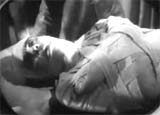 Flashback: As Punishment, Imhotep Was Mummified and Buried Alive in a Nameless Grave 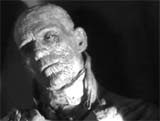 The Slow Resurrection of Imhotep 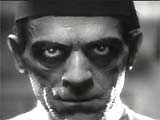 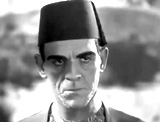 The Entrance of Ardath Bey, 10 Years Later 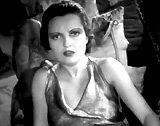 Ardath Bey's First View of Helen 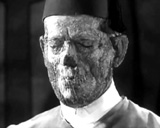 The Crumbling of Ardath's Face and Body |
||||||||||||||||||||||
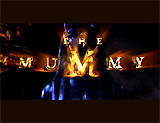
|
The scariest scene of director Stephen Sommers' big-budget remake came after a battle scene with Imhotep's resurrected mummy priests. It was highlighted by the final demise of Beni Gabor (Kevin J. O'Connor), a cowardly and greedy treasure-seeker. After gathering treasure for himself, Beni became trapped and entombed in a large underground vault, and quickly surrounded by a vast swarm of screeching, crawling, flesh-eating scarabs. The beetles devoured him as the screen turned black when his torch extinguished. |
 Death by Swarming Scarabs in Underground Vault |
||||||||||||||||||||||
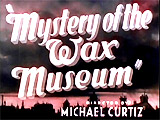
|
Mystery of the Wax Museum (1933) Director Michael Curtiz' and Warner Bros.' Technicolored (two-strip colors of greens and reds), 79 minute expressionistic mystery-horror film was the next effort to capitalize on the success of the similar Doctor X (1932); it was the last significant feature film to be made with the two-color Technicolor process. The exciting and frightening gothic horror film again starred Lionel Atwill and Fay Wray; the initially-lost film was remade by director Andre De Toth as House of Wax (1953) (in 3-D), starring Vincent Price. Roger Corman's Bucket of Blood (1959) also used a similar storyline. The Pre-Code film was noted for its female leads prancing around in silky underwear or tight outfits, heroin and drug addiction, sexy double-entendre dialogue, bootlegging and multiple murders:
|
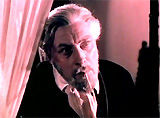 Igor Survived Fire - Reappeared in NY in 1933 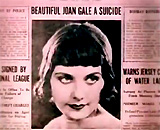 Joan Gale Suicide 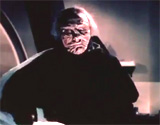 Mysterious Figure with Scarred Face Rising Up From Under Sheet in Morgue 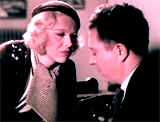 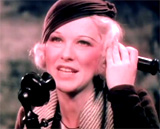 Plucky Reporter Florence Dempsey (Glenda Farrell) with Editor Jim (Frank McHugh) 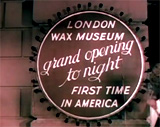 New Museum Opening in NYC in 1933 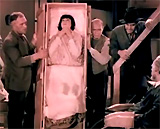 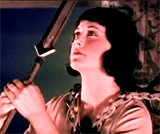 New Statue of Joan of Arc 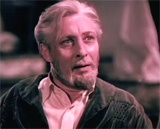 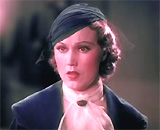 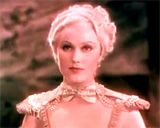 Charlotte (Fay Wray) - Told By Igor That She Looked Like His Marie Antoinette Waxed Statue 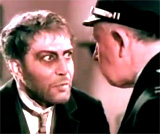 D'Arcy Confessing to Police: "It was Igor at the Wax Museum...The whole place is a morgue!" 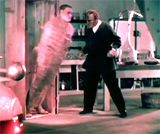 Igor Revealing to Charlotte the Mummified Body of "Fiendish" Joe Worth in a Coffin Box 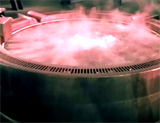 The Museum's Giant Bubbling Vat of Wax 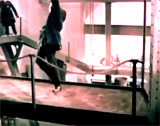 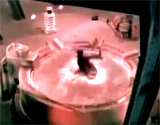 Igor Shot on Catwalk - Sending Him into Hot Wax Cauldron |
||||||||||||||||||||||
Intro | #s-A | B | C-1 | C-2 | D-1 | D-2 | E | F | G | H I-J | K-L | M | N-O | P | Q-R | S-1 | S-2 | S-3 | T | U-Z |